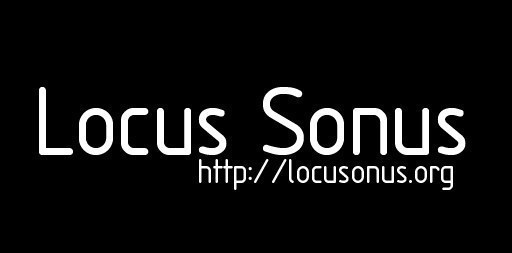|
symposium #6
mar2010
Sonification (what, where, how, why)
LOCUS SONUS audio in art
http://locusonus.org/
du 4 au 5 mars 2010 / from the 4th to the 5th of March 2010
École Supérieure d'Art d'Aix en Provence
http://www.ecole-art-aix.fr/
MMSH - Maison Méditerranéenne des Sciences de l'Homme
http://www.mmsh.univ-aix.fr/
|
menu
|
participants
| |
|
Jérôme Joy
 |
What NMSAT says about sonification
(Ce que dit le NMSAT au sujet de la sonification)
This presentation will probe into the NMSAT historical references concerning sonification.
Info :
Networked Music and SoundArt Timeline : a panoramic view of practices related to sound transmission and distance
This timeline aims to provide an overview of the principal events and projects in the realm of networked music and networked sonic performance since the beginning of the XX° century. The objective of this project is to reveal or uncover links between disciplines often considered separately such as art/music, technological development, social shifts, anticipationary visions & proleptic statements. This will in turn provide a clearer vision of the very recent history of soundart and music in todays networked technological environment. The current iteration was in launched 2008 within the context of the Locus Sonus research lab one of whichs vocations is to provide a corpus of information for documentary and critical use available to researchers, artistes and the arteducation community in general. It is nourished by parallel research, developed in recent years within Locus Sonus, concerning remote sound recording and playback, live audio streaming, and ‘geotagged’ sound projects.
Historique de l'art audio et de la musique en réseau : panorama des pratiques et techniques liées aux transports de sons et aux actions sonores à distance, comme nouveau paradigme de l'écoute
Cet Historique (Timeline NMSAT) vise à fournir une vue d’ensemble des événements et projets artistiques principaux dans les domaines de la musique et de la performance sonore en réseau depuis le début du XXème siècle. L’objectif de ce projet est de révéler et de découvrir des liens et des croisements entre des disciplines le plus souvent observées séparément, telles que art et musique, les sciences et technologies, les modifications sociales et observations sociologiques, les approches philosophiques, et des états visionnaires (et proleptiques) présents dans ces domaines et dans la littérature d’anticipation.
pdf NMSAT presentation (download)
pdf NMSAT excerpts (download)
→ url
back to programme &mdash back to participants
Jérôme Joy is a composer and networks artist who has been teaching since 1992 at the National School of Arts, Villa Arson Nice and since 2004 as research director with Peter Sinclair of the research group Locus Sonus - Audio in Art. Having delivered multiple performances of both instrumental and electro-acoustic music since the early 1980s, he has devised numerous international networked projects and collectives (in music, sound and net) since 1995. His interests encompass the vast realm of sound composition, alighting upon and inspired by electronic production, programming technologies, networked systems, shared databases and the interplay and local gaps of narration into our daily life and social contexts. He's continuously working on various projects of network music : Sobralasolas !, nocinema, picNIC, Collective JukeBox, etc.
Compositeur et artiste-enseignant à l'École Nationale Supérieure d'Art de Nice Villa Arson depuis 1992, Jérôme Joy coordonne le laboratoire de recherche 3ème cycle Locus Sonus audio in art avec Peter Sinclair et Anne Roquigny. Après un parcours de performances et de concerts instrumentaux et électroacoustiques à partir de 1982, il développe depuis 1995 de nombreux projets en réseau (concerts, database sonore participative, musique électronique, radiophonie, cinéma et performances). Ses projets et concerts, personnels ou en collectif, sont présentés dans de nombreux festivals, colloques et événements internationaux. Ses dernières réalisations sont tournées vers les réseaux et la radiophonie, et plus spécialement vers les concerts de musique en réseau - Collective JukeBox, picNIC, nocinema.org, PacJap, pizMO, Lib_, Disklavier, nnybinap, Sobralasolas ! -.
Publications récentes / recent writings :
- Networked Sonic Spaces, Locus Sonus. by Jérôme Joy & Peter Sinclair, In Proceedings ICMC'08 (International Computer Music Conference), "Network Performance", pp. 553-555, SARC Belfast, Queen's University, Tampere: GlobalWare Corporation, 2008.
- Espaces Sonores en Réseau - pratiques de la recherche en art, Locus Sonus. by Jérôme Joy & Peter Sinclair, In "Recherche & Création - Art, Technologie, Pédagogie, Innovation", sous la direction de Samuel Bianchini, pp. 122-139. Paris: Éditions Burozoïque / Les Éditions du Parc, École Nationale Supérieure d’Art de Nancy, 2009.
- Networked Music & Soundart Timeline (NMSAT): A Panoramic View of Practices and Techniques Related to Sound Transmission and Distance Listening. by Jérôme Joy & Peter Sinclair, In Contemporary Music Review, "Network Performance", Vol. 28, Nos 4/5, , pp. 351-361, Taylor & Francis Group, Oxford: Routledge (UK), 2009.
- Networked Music & Soundart Timeline (NMSAT) Excerpts of Part One: Ancient and Modern History, Anticipatory Literature, and Technical Developments References. by Jérôme Joy, In revue Contemporary Music Review, "Network Performance", Vol. 28, Nos 4/5, pp. 449-490, Taylor & Francis Group, Oxford: Routledge (UK), 2009.
|
| |
--> http://jeromejoy.org
--> http://nocinema.org
--> http://locusonus.org/
|
| |
|
Roger Malina
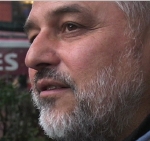 |
Moderator Roundtable 1 : There is more space beneath - nano, micro data
pdf roundtable 1 (download)
back to programme &mdash back to participants
Roger F Malina is an astrophysicist and editor. He is Director of the Laboratoire d'Astrophysique de Marseille (CNRS) and former Director of the NASA EUVE Observatory at the University of California, Berkeley. He is a co-investigator for the Supernova Acceleration Probe Mission which seeks to understand the nature of dark energy in the universe, and a member of the science team of the Galaxy Evolution Explorer which is mapping the sky in the far ultraviold to understand the evolution of galaxies over 80% of the age of the universe. He is a member of the International Academy of Astronautics and Secretary of Commission VI on Space Activities and Society, and co-chair of the International Advisory Board of the Inter-Society for the Electronic Arts and a member of the International Academy of Astronautics. Roger Malina serves as the Chairman of the Board of Leonardo/ISAST, The International Society for the Arts, Sciences and Technology, in San Francisco and as the Executive Editor of the Leonardo publications, he is President of the Association Leonardo in Paris.
He writes on art and science and is particularly interested in the cultural dimensions of space activities. He is currently working on a project of the satellite SNAP and on the mystery of black energy and black matter in Universe.
Roger F. Malina est astronome et éditeur. Il est chercheur CNRS au Laboratoire d'Astrophysique de Marseille et ancien directeur de l'Observatoire de la NASA EUVE à l'Université de Berkeley, Californie. Il est Président du Conseil d'Administration de Leonardo/ISAST, San Francisco et Président de l'association Leonardo/Olats, Paris ainsi que rédacteur des publications Leonardo au MIT Press. Il écrit sur l'art et la science et a un intérêt particulier pour les
dimensions culturelles des activités spatiales.
Il travaille actuellement sur un projet de satellite, SNAP, sur le mystère de l'énergie noire et la matière noire dans l'Univers.
|
| |
--> http://www.oamp.fr/
--> http://www.leonardo.info/
--> http://www.olats.org/ |
| |
|
Peter Gena
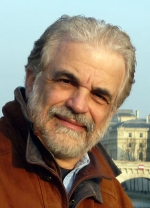 |
About sonification
In music, the idea of sound as an actual structural element only gained currency after World War II. I will outline briefly the history of this, citing significant composers and works. In addition, I will present samples of several sonification projects of my own from early work in realizing three-dimensional images (1972), and brain-wave music (1974-75) to the realization of DNA sequences (1995-present).
back to programme &mdash back to participants
Peter Gena, Ph.D studied music composition with Morton Feldman, Lejaren Hiller. His work of various media have been presented extensively in North and South America, Europe, Asia, and Australia. Performances/installations include works presented at Les Nuits Numériques #7-Nanomonde at Le centre culturel Saint-Exupéry in Reims; Espace Sextius / Seconde Nature, Aix-en-Provence; Centro Andaluz de Arte Contemporàneo (CAAC); Seville, Spain, The Art Students League of New York, Computing Music IV (Cologne 2006), The Pandemic Night/La Notte Bianca (Milan 2006), Festival d'Automne (2004), Paris; Museo Nacional de Bellas Artes, Buenos Aires; the Berkeley Art Musuem (2003); Mini to the Max (2002), at the Brisbane Powerhouse, Australia; the Universidad de Salamanca, Spain, (2002); Arte al Centro 2001, at Cittadellarte/Fondazione Pistoletto, Biella; The National Gallery of China, Beijing (2001); Ars Electronica 1999, Linz; Aspekte Salzburg 1997; The International Computer Music Conference, Hong Kong; L.A.C.E., Los Angeles; San Juan University and the Poncé Museum of Art, Puerto Rico; Akademie der Kunst, Berlin; Herbst Theater, San Francisco; the Asian Institute for Liturgy and Music, Quezon City, Phillipines, The Ferienkurse f¨r Neue Musik in Darmstadt, Germany; the Merkin Concert Hall and Lincoln Center in New York, the 1991 Sao Paulo Bienal, New Music America 1981, 1982 & 1990. Similarly, as a pianist he has publicly performed many of his own works as well as those of others.
Gena's publications include, Freedom in Experimental Music: the New York Revolution (TriQuarterly 52); A John Cage Reader, in celebration of the composer's 70th Birthday (C.F. Peters Inc., NYC, 1983 [hardcover]); John Cage and the New York School: A Hyperlecture/Conversation (Warsaw Contemporary Art Museum, 1994) and a contribution to The Waltz Project (Nonesuch Records), choreographed by Peter Martins and in the repertory of the New York City Ballet. His essay Cage and Rauschenberg: Purposeful Purposelessness Meets Found Order accompanied the exhibitions, Robert Rauschenberg: The Early 1950s,and John Cage: Scores from the Early 1950s, shown at the Museum of Contemporary Art in Chicago. A paper, A Physiological Approach to DNA Music, was presented and published at CADE 2001, in Glasgow; and at the Art and Science Global Symposium, Tsinghua University, Beijing.
Since 1983, Gena has been a Professor at the School of the Art Institute of Chicago, where he teaches electronic and computer music, music history, computer programming, and interdisciplinary courses. Gena is decorated by the French government at the rank of Chevalier dans l'Ordre des Palmes Académiques.
Peter Gena, Ph.D. a étudié avec Morton Feldman, Lejaren Hiller. Ses oeuvres ont été présentées de nombreuses fois Amérique du Nord et du Sud, Europe, Asie, et Australie (voir plus haut).
En tant que pianiste et interprète, il joue ses propres oeuvres ainsi que celles d'autres compositeurs.
Les publications de Peter Gena comprennent plusieurs articles: Freedom in Experimental Music: the New York Revolution (TriQuarterly 52); A John Cage Reader, pour la célébration du soixante-dixième anniversaire de John Cage (C.F. Peters Inc., NYC, 1983); John Cage and the New York School: A Hyperlecture/Conversation (Musée d'art contemporain de Varsovie, 1994) et une contribution à The Waltz Project (enregistré sous le label Nonesuch). Peter Martins a fait une choréographie pour le répertoire du ballet de New York City. Son essai "Cage and Rauschenberg: Purposeful Purposelessness Meets Found Order" a accompagné les expositions, Robert Rauschenberg: The Early 1950s, et John Cage: Scores from the Early 1950s, montrées au musée de l'art contemporain de Chicago. Un exposé, A Physiological Approach to DNA Music, (une approche physiologique à propos de musique générée à partir de séquences numériques ADN), a été présenté et publié à CADE 2001, à Glasgow; et au Colloque Global d'art et Science à l'université de Tsinghua, Pékin.
Depuis 1983 Peter Gena est professeur à la School of the Art Institute of Chicago, où il enseigne la musique électronique et assistée par ordinateur, l'histoire de musique, la programmation informatique et des cours interdisciplinaires. Gena est décoré au rang du Chevalier dans l'Ordre des Palmes Académiques.
|
| |
--> http://www.petergena.com/
mp3s:
-->http://www.petergena.com/compmus.html
-->http://www.petergena.com/FR/ADNmus.html
-->http://www.petergena.com/MP3s,etc.html/ |
| |
|
Lee Patterson
 |
Bubble Music
Water as a medium for the sonification of photosynthetic respiration in aquatic plants. - a short presentation with sound examples.
Bubble Music: water as a medium for the sonification of organic activity
Over the past five years, as part of a broader practice that investigates environmental materials for sonic potential, I have been making field recordings using self-built hydrophones within various fresh water bodies, such as ponds, rivers, lakes, streams and canals.
This approach to the aqueous medium has revealed a host of previously unexpected sounding phenomena within specific environments.
Many sounds encountered now seem less remarkable given what one knows of the world above the water surface, aquatic insect calls (stridulation), fish feeding and communicating, the action of moving water over different surfaces and such like.
However, phenomena that have taken longer to understand, are the sounds produced by certain species of aquatic plants and the roles played by liquids in this seemingly bizarre occurrence.
As with the interaction of air upon air, it’s hard to say whether the action of water on water creates any sound, however where transducers exist, such as the waters’ own surface tension - where liquid meets gas, or on a river bed, where liquid interacts with solid, the energy of moving water is transduced, undergoing a change of state from the kinetic energy of flow into vibrations that may be perceived as sound.
The transpiration of the gases produced by photosynthetic respiration in plants above water, makes no sound (at least, non that can be perceived given current technologies), however carbon dioxide and oxygen released by sub-aquatic flora, if not dissolved within the water itself, is naturally forced to form bubbles if released in sufficient quantity. Due to the interaction of gas and water forming the surface tension of a bubble, and then the action of the bubble as it is released from the plants’ stomata, sound is produced. Such sound is often heard as a click or a pulse, and where many plants are present and releasing gas, a dense field of ticks and clicks may be heard corresponding to individual rhythms of respiration.
However, in a similar fashion to the way in which pulses from electronic wave generators or synthesizers are perceived as tone given sufficient cycle speeds, if respiratory rhythm is sufficiently rapid, then these clicks can become tonal sound forms.
In organisms such as Hornwort (Ceratophylum Demersum), bubbles are released with such speed in the summer months, that tones, drones and siren-like pulses of various types may be produced and in such cases, a pond or canal can occasionally sound more like the electronic music studio.
This sonification process reveals changes in photosynthetic activity corresponding to shifting light levels, ambient aquatic temperatures and even, possibly, threat or disturbance to the plant from external sources.
(Lee Patterson, February 2010)
back to programme &mdash back to participants
Working across various forms, including improvised music, field recording, film soundtrack and installation, Lee Patterson attempts to understand his surroundings through different ways of listening.
Characterised by revealing subliminal and barely audible sound materials within commonplace things, his unorthodox approach to generating sound has led to collaborations with a host of international artists and musicians.
Recent CD releases include Egg Fry #2, Midhopestones, with Phil Minton, Michel Doneda, Louisa Martin and Rhodri Davies; Bouy with Paul Vogel and Phil Durrant, and Terrain with Graham Halliwell.
His premier solo disc, Seven Vignettes was released in May 2009.
His solo and collaborative work has featured on Channel 4, BBC Radio 3 and 4, Resonance FM and on several European radio stations.
He is currently artist in residence at Stour Valley Arts, Kings Wood, Challock, Kent.
Born in the east of England in 1971, he resides and works in Prestwich near Manchester.
(English version bio only)
|
| |
--> |
| |
|
Victoria Vesna
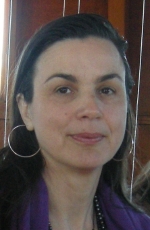 |
Sound, Science and Consciousness
back to programme &mdash back to participants
Victoria Vesna is a media artist, Professor at the Department of Design | Media Arts at the UCLA School of the Arts and Visiting Professor and Director of Research of the Art, Media and Technology Program at Parsons The New School of Design. She is also director of the UCLA Art|Sci center that resides in two locations – Broad Arts and California Nanosystems Institute (CNSI).
Her work can be defined as experimental creative research that resides between disciplines and technologies. She explores how communication technologies affect collective behavior and how perceptions of identity shift in relation to scientific innovation.
Victoria Vesna has exhibited her work in 18 solo exhibitions, over 70 group shows, published 20+ papers and gave a 100+ invited talks in the last decade. She is recipient of many grants, commissions and awards, including the Oscar Signorini award for best net artwork in 1998 and the Cine Golden Eagle for best scientific documentary in 1986 and best artwork award at the International Shanghai Art & Science exhibition in 2008. She holds a Ph.D. from the University of Wales, UK, is the North American editor of AI & Society and author of Database Aesthetics: Art in the Age of Information Overflow. In Press is Context Providers: Negotiating Meaning in Media Arts co-edited by Margot Lovejoy and Christiane Paul.
Victoria Vesna est une artiste Nouveaux Medias. Professeur du département de Design & Media Art de l’UCLA (Université de Californie, Los Angeles), elle est aussi Professeure invitée et directrice de recherche artistique à l’Université de Parsons, the New School for Design. Victoria Vesna a fondé le centre Art & Sciences au sein de l’UCLA. Elle en assume la direction. Les activités de ce centre se déroulent à la fois dans le domaine artistique (Broad Arts) et le domaine scientifique (California Nanosystems Institute [CNSI]).
L’œuvre de Victoria Vesna pourrait être définie comme la recherche fondamentale d’une symbiose entre arts et technologies. Elle explore l’influence des technologies de communications sur le comportement collectif, et les moyens d’adaptation de l’individu face aux nouveautés scientifiques. Elle a présenté son travail lors de 18 expositions individuelles et plus de 70 expos collectives; elle a aussi publié une vingtaine d’essais et, aux cours de cette dernière décennie, a donné une centaine de conférences.
Elle est lauréate de nombreux prix, entre autres: l’Oscar Signorini en 1998 pour la meilleure œuvre d'art internet, en 1986 pour l'Aigle Royal Cine (le meilleur documentaire scientifique), le Grand Prix à l'exposition International Shanghai Art & Science, en 2008. Son travail est reconnu sur le plan international, il a été publié aux USA (Art in America, National Geographic, the Los Angeles Times), en Italie (Tema Celeste), en Allemagne (Spiegel), en Irlande (The Irish Times) etc.…
Née à Washington D.C, Victoria Vesna a obtenu son doctorat à l'université du Pays de Galles, en Angleterre. Elle est la rédactrice du journal AI & Society pour l’Amérique du Nord, l'auteur de ‘Database Aesthetics: Art in the Age of Information Overflow.’ (Esthétique des Bases de données: comment aborder de manière esthétique le débordement actuel d’informations). Elle est également co-éditrice de ‘Context Providers: Negotiating Meaning in Media Arts ‘avec Margot Lovejoy et Christiane Paul.
|
| |
--> http://vv.arts.ucla.edu/ |
| |
|
Peter Sinclair
 |
Moderator Roundtable 2: Humans, habitat and sonification
RoadMusic - Autosync
Road Music reinvents the banal experience of listening to music while driving in a car, by replacing the sound ordinarily produced by the radio cd or mp3 player with sounds - music produced from the action of the car itself. Gear changes, vibrations, bends in the road, accelerations, bumps, and the passing landscape are instrumentalized creating music specific to each journey.
Le principe de RoadMusic – AutoSync réinvente l’expérience très commune d’écouter de la musique en voiture, en remplaçant le son produit habituellement par la radio, le lecteur cd ou mp3 par le bias d'une dispositif qui produit des sons à partir de l’action de la conduite et de la voiture elle-même. Changements de vitesse, vibrations, état de la route, deviennent ainsi les instruments d’une musique propre à chaque voyage.
back to programme &mdash back to participants
Interventions précédentes et récentes / Previous and recent lectures
 écoute/listen mp3 Audio Extranautes (symposium 3 Audio Sites, 2006) écoute/listen mp3 Audio Extranautes (symposium 3 Audio Sites, 2006)
Peter Sinclair is a digital media and sound artist. He is tenured professor at Ecole Superieure d'Art d'Aix-en-Provence where he has been responsible for the sound department since 1996. He is also currently a member of the scientific council for research and studies at the DAP (fine arts department) of the French Ministry for Culture and research co-director with Jérôme Joy of Locus Sonus lab audio in art, which is a collaboration between two Schools of Arts, ESA Aix-en-P and ENSA Nice Villa Arson, and the sociology laboratory LAMES CNRS-MMSH. Peter Sinclair is known for his sound installations and other cross-disciplinary works which use sound as their principal medium. Excited by technology but handling it with critical irony, his work has moved from burlesque mechanics, through the misuse of computers to performance that parodies modern media language in transatlantic streamed-collaborations. Aside from his personal artistic productions Peter Sinclair participates in various collectives as "PacJap" and "Daisy Chain" and he has been working with New-York based artist GH Hovagymian since 1996.
Peter Sinclair est un artiste principalement connu pour ses installations sonores et ses réalisations utilisant l'audio comme principal médium. Engagé dans des pratiques artistiques liées aux technologies il manipule ces médiums avec un regard critique, parfois ironique, mettant en oeuvre des rencontres entre hommes et machines pour créer des situations inédites. Son travail évolue de la mécanique burlesque, en passant par le détournement d'ordinateurs, jusqu'à la performance - son oeuvre parodie le langage des media modernes via des collaborations en réseau. Il enseigne à l'École Supérieure d'Art d'Aix-en-Provence où il est responsable du département son depuis 1996. Il est aussi membre du Conseil Scientifique du Bureau de la Recherche et de l'Innovation de la Délégation aux Arts Plastiques du Ministère de la Culture et co-dirige avec Jérôme Joy le laboratoire de recherche et cursus 3ème cycle Locus Sonus audio in art.
|
| |
--> http://petersinclair.org/
--> http://nujus.net/~petesinc/
--> http://locusonus.org/ |
| |
|
Lorella Abenavoli
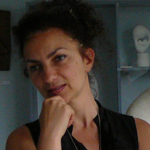 |
La sonification dans les arts visuels et médiatiques : une remédiation de l'empreinte
(Sonification in Digital & Visual Arts)
back to programme &mdash back to participants
Lorella Abenavoli is an artist living between France and Canada. Since 1996 she has devoted her time to sound sculpture, transforming into sound the internal flows of the Earth, trees, body, cosmic events, working with scientific institutions. She makes exhibitions in France, Italy, Canada and the United States. She has been awarded grants from the Daniel Langlois Foundation and the French Ministry of Culture, for her artwork The Pulse of the Earth. She’s presently working on sound creation for dance, collaborating with the French choreographer Bernardo Montet. Their last creation, Batracien, l’après-midi, has been showing around the world. Whilst currently doing a PhD art program at UQÀM in Montreal, she's producing research about sound medium in the visual art field. She's artistic director of Avatar Québec since Nov. 2009.
Lorella Abenavoli vit et travaille à Montréal. Elle est sculpteure électro acousticienne. Elle effectue actuellement un doctorat en Etudes et Pratiques des arts, interrogeant la place et la fonction du medium sonore dans les arts plastiques et médiatiques, à l'Université du Québec à Montréal pour lequel elle a reçu une bourse d'excellence du Gouvernement du Québec. Depuis le 1er novembre 2009 elle est directrice artistique du centre d'artiste Avatar à Québec, Centre d'art audio et électronique (www.lenomdelachose.org).
Après des études effectuées dans le cadre d’un programme expérimental arts/sciences/technologies, elle s’est fait connaître par une série d’œuvres exploitant les propriétés dynamiques de la matière, travaillant entre autres l’eau et le bitume, avant d’orienter ses recherches vers l’exploration du matériau sonore qu’elle travaille et met en œuvre dans le cadre d’installations électroacoustiques. Sa recherche est basée sur la captation et la transformation des flux intérieurs de la Terre, des arbres, du corps, du cosmos, etc., constituant une poésie sonore du vivant.
Son œuvre « Le Souffle de la Terre », qui transpose dans le domaine audible les vibrations infragraves du globe terrestre, a connu un large retentissement médiatique. Elle a réalisé ce projet transdisciplinaire en collaboration avec l’UTC et IPGP. Elle est boursière de la Fondation Daniel Langlois – Montréal - en 2000, reçoit le soutien de la DRAC Ile de France en 2001 et celui du Ministère de la Culture - Dicream- en 2003. Elle est accueillie en résidence au Studio National d’Art Contemporain du Fresnoy en 2003-2004 où elle réalise la première maquette temps-réel du Souffle de la terre, puis est invitée à l’Ircam dans le cadre de la manifestation internationale « Résonances 2004 ». Depuis, cette œuvre est exposée en France et à l’étranger.
Elle travaille aujourd’hui à la réalisation de nouvelles sculptures sonores révélant les rythmes des arbres, des astres, du corps, du cosmos. Sa dernière œuvre installative Nox Mater réalisée avec l’artiste Nicolas Reeves vient d’être exposée en septembre 2007 à la MEP - Paris, dans le cadre du festival d’art numérique @rtOutsiders et sa dernière création sonore pour le solo de Bernardo Montet, Batracien, l’après-midi est jouée actuellement en France et dans le monde. Elle est membre du réseau MARCEL et enseigne au Cegep du Bois-de-Boulogne à Montréal.
|
| |
--> http://www.lenomdelachose.org/
--> http://www.avatarquebec.org/
--> http://www.fondation-langlois.org/html/f/page.php?NumPage=268
--> http://www.ekac.org/dpi.11.html
--> http://www.oboro.net/archive/exhib0405/lorella_abenavoli/e.html
--> http://personnagesvirtuels.org/conf/abenavoli.html |
| |
|
Jean Cristofol
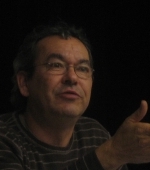 |
...
back to programme &mdash back to participants
Interventions précédentes et récentes / Previous and recent lectures
 écoute mp3 Régimes de visibilité (symposium 3 Audio Sites, nov 2006) écoute mp3 Régimes de visibilité (symposium 3 Audio Sites, nov 2006)
 écoute mp3 Les formes d'organisation du temps et de l'espace (ESA Aix en Prov, 2005) écoute mp3 Les formes d'organisation du temps et de l'espace (ESA Aix en Prov, 2005)
 écoute mp3 Le bien commun - 1 (Radio Grenouille, 2006) écoute mp3 Le bien commun - 1 (Radio Grenouille, 2006)
 écoute mp3 Le bien commun - 2 L'appriopriation du savoir (Radio Grenouille, 2006) écoute mp3 Le bien commun - 2 L'appriopriation du savoir (Radio Grenouille, 2006)
 écoute mp3 Le bien commun - 3 La gestion des biens communs (Radio Grenouille, 2006) écoute mp3 Le bien commun - 3 La gestion des biens communs (Radio Grenouille, 2006)
 écoute mp3 Partage du savoir (ESA Aix en Prov, janv 2007) écoute mp3 Partage du savoir (ESA Aix en Prov, janv 2007)
(French version bio only)
Philosophe, épistémologue, enseignant à l'ESA Aix-en-Provence (approche scientifique), Jean Cristofol propose une réflexion sur la notion même de "temps réel", et le cadre théorique et pratique dans lequel elle prend sens, celui qu'engage les dispositifs technologiques interactifs. Au-delà, il s'agit de prendre en compte la constitution d'une configuration conceptuelle (boîte noire, feedback et régulation, code et information, interface, simulation...) qui trouve ses sources dans la cybernétique, et qui continue, pour une large part, à déterminer l'horizon épistémique et imaginaire dans lequel s'élaborent ces dispositifs. C'est à partir de ce point de vue que le temps réel pourra être considéré comme lieu de croisement d'une réflexion qui suit plusieurs pistes : celle qui interroge les transformations de notre rapport à l'espace social et politique, l'apparition de modes nouveaux de représentation et d'action dans le monde de ce que Virilio appelle la "transapparence"; celle des modalités de l'inscription temporelle des arts visuels avec la photographie, le cinéma, la vidéo puis le numérique; celle enfin qui prend en compte le déplacement de la réflexion "esthétique" des objets vers les dispositifs, de la contemplation vers l'interaction. Ceci permet une approche théorique et critique d'un certain nombre des concepts dans lesquels les pratiques technologiques se pensent ou se projètent.
Il anime le laboratoire Plot au sein du programme de recherche Agglo, avec Fabrice Gallis et Guillaume Stagnaro.
Il interviendra en février prochain au colloque "SuperVitesse et WikiMémoire" (impact des nouvelles technologies sur l'imaginaire), organisé à Québec par Avatar - Vacuohm en collaboration avec Les Productions Recto-Verso et l'École des arts visuels de l'Université Laval.
Bibliographie:
CRISTOFOL, Jean. - "Inscriptions et singularité", Art / Cognition (Cyprès - École d'Art, Aix en Provence, 1993)
CRISTOFOL, Jean. - "Prédiction, Variation, Imprévu", Laboratoire Plot (Agglo - programme de recherche, 2003-2006)
|
| |
--> http://plotseme.net/
--> http://www.agglo.info/ |
| |
|
Stuart Jones
 |
People and Data, space to sound : representation, perception and performativity
back to programme &mdash back to participants
Stuart Jones is a composer and media artist, and also Senior Research Fellow in Interaction Design at Central Saint Martins. He co-founded Gentle Fire in 1968 and also worked with John Cage and Karlheinz Stockhausen. He has worked with space and interaction throughout his career, creating his first interactive installation in 1973. He has a long standing interest in non-European music, and in particular has studied and performed on the pi’pa and guzheng. His current research at CSM is into the use of sound to reconfigure space, and how children experience narrative. Recent CD releases include given – taken, for cello, pisaw and electronics (divers music 012) and Gharnati for violin and percussion (on Fiddlesticks, Signum SIGCD111); recent installations are Wigg Island Birds for a nature reserve on the Mersey, and Big Ffidil for the Wales Millennium Centre.
(English version bio only)
|
| |
--> http://www.wawamoz.com/ |
| |
|
Atau Tanaka
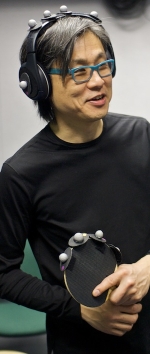 |
Views into Acts of Sonification
Sonification has two meanings:
- 1. Scientific sonification, as the aural equivalent of scientific visualization
- 2. As a way to bring things to sonic life
In April 2009, I took part in a panel discussion at the Theatre Noise conference in the Central School of Speech and Drama in London where the panelists were Ross Brown, theatre sound designer, the soundscape artist John Drever, Michael Bull, cultural theorist, and myself. Here is Ross Brown’s abstract for that session.
“In Oslo airport there are listening points, marked by circles on the floor, where one can step out of the ambience of the departures lounge and into a noise-cancelled zone within which one encounters the sounds of gurgling babies, whispering voices and tumbling surf. The theatrical sound effect seems to have escaped captivity and adapted. The post-industrial soundscape is no longer simply divided into signal and noise, but has been invaded by sonic tricks, illusions and puns. Ringtones have become a form of sonic bling. The processes of inferring from effect have become less straightforward. A mechanical shutter sound is now more likely to signify the presence of a mobile phone than a camera. A dog bark might be a door bell. Birthday cards play digital samples and the act of remotely unlocking or locking a car involves more waveform synthesis and digital sound processing than Kraftwerk could afford onstage in 1979. ‘Sonification’ has gone way beyond user-interface functionality. Digital phones that sound like old-fashioned analogue ones but with a built in reverb effect to make them sound like they are ringing in a different, more sonically luxurious world. This panel will consider the effects of this environmental theatre of sound, and the ways in which the live arts might respond.” Ross Brown 2009.
The tension between the two meaning of the word sonification came to light in this session, and I will retrace this discussion in my presentation.
back to programme &mdash back to participants
Interventions précédentes et récentes / Previous and recent lectures
 Publications Sony Computer Science Laboratory Paris Publications Sony Computer Science Laboratory Paris
 écoute mp3 BioMuse (Arte Radio) écoute mp3 BioMuse (Arte Radio)
Atau Tanaka was born in Tokyo, and was raised in the U.S. He bridges the fields of media art, experimental music, and research. In Paris has worked at IRCAM, was Artistic Ambassador for Apple France, and conducts research at Sony Computer Science Laboratory (CSL) Paris. Atau performs with sensor based musical instruments and composes for mobile network systems. His works include solo and ensemble concert works and exhibition installations. His work has been presented at Ars Electronica, SFMOMA, Eyebeam, V2, ICC, and ZKM. He has received support from the Fondation Daniel Langlois and has been mentor at NESTA. For the 2007 season, he was Artistic Co-Director of STEIM in Amsterdam. He holds the Chair of Digital Media at Newcastle University in the U.K., and is Acting Director of Culture Lab.
Atau Tanaka est né au Japon en 1963, il a grandi aux États-Unis et a étudié à Harvard University, au Peabody Conservatory et au CCRMA (Center for Computer Research in Music and Acoustics) de l'Université de Stanford. En 1992, il obtient une résidence à la Cité des arts et travaille au département pédagogique de l'IRCAM. Il a également été artiste en résidence ainsi que Co-Directeur Artistique au STEIM, au V2 et "ambassadeur artistique" pour Apple Europe dans le cadre de sa recherche en musique interactive. En 1997, il s'installe à Tokyo sur l'invitation de NTT/ICC (Inter Communication Center). Il a reçu de nombreux prix et le soutien du GMD/Fraunhofer Society, et celui de la Fondation Daniel Langlois pour son travail en installation musicale sur réseau. Le travail d'Atau Tanaka porte sur des instruments avec capteurs sensoriels et des installations et performances sonores en réseau. Dès 1990, il adoptait le procédé Biomuse, fondé sur un système de capteurs électromyograme permettant de transformer le corps en véritable instrument multimédia. Il a été chercheur au laboratoire Sony CSL Paris jusqu'à cette année. Depuis 2007, il a rejoint l'équipe de Culture Lab à L'Université de Newcastle, où il a à présent une chaire d'enseignement et de recherche en Digital Media.
|
| |
--> http://www.xmira.com/atau/net_derive/
--> http://www.ncl.ac.uk/culturelab/
--> http://www.fondation-langlois.org/html/f/page.php?NumPage=285
--> http://www.csl.sony.fr/staff/member/?username=atau
|
| |
|
Samuel Bordreuil
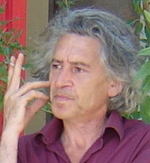 |
Moderator Roundtable 3 : Sonification and Artifacts
pdf roundtable 2 (download)
back to programme &mdash back to participants
Interventions précédentes et récentes / Previous and recent lectures
 écoute/listen mp3 Audio Extranautes (symposium 4 Audio Extranautes, 2007) écoute/listen mp3 Audio Extranautes (symposium 4 Audio Extranautes, 2007)
 écoute/listen mp3 Faire paysage: Landscaping versus scape landing (symposium 3 Audio Sites, nov 2006) écoute/listen mp3 Faire paysage: Landscaping versus scape landing (symposium 3 Audio Sites, nov 2006)
 écoute/listen mp3 Dog poop girl (université FING, juin 2006) écoute/listen mp3 Dog poop girl (université FING, juin 2006)  (pdf) (pdf)
(French version bio only)
Samuel Bordreuil is Senior Research Scientist, Centre National de la Recherche Scientifique (CNRS). Director of Laboratoire Méditerranéen of Sociology (LAMES) [Mediterranean Center for Sociology], Maison Méditerranéenne des Sciences de l'Homme (MMSH), Aix en Provence.
Areas of research:
Urban sociology, micro sociology of public space, in particular:
- Physical space, social space: the "sense of place"
- Territories and democracy
- Public dimensions of new ITC and their usages
- Artistic engagement and the construction of publics.
Sociologue, Directeur de Recherche au CNRS, Directeur du LAMES (Laboratoire Méditerranéen de Sociologie) à la MMSH d'Aix-en-Provence.
Ses recherches portent principalement sur la dimension publique de la vie sociale, telle qu'elle s'incarne dans les espaces urbains, qu'elle se développe en sphères de débats (publics), qu'elle se manifeste au travers de mobilisations collectives (construction de publics). Dans ce cadre il porte une attention particulière aux nouveaux espaces et régimes de publicité portées par l'expansion des technologies du numérique.
Publications récentes / recent writings :
- L'histoire de la 'Dog Poop Girl' revisitée : usages et mésusages d'un médium hétérotopique, in Réseaux, numéro spécial sur les blogs, automne 2006.
- A l'orée du monde, le monde, conférence donnée dans le cadre des journées sur "mobilités et mondialisation", décembre 2003, organisées par Dana Diminescu, MSH Paris et Anne Marie Morice, Synesthesie.com.
Texte et vidéo accessibles sur www.msh-paris.fr et sur le site de Synesthésie.
Il a publié en 2007 dans Libération un article remarqué sur la Nouvelle-Orléans.
Contributions antérieures à des ouvrages collectifs :
La Ville desserrée, in "La ville, l'urbain : l'état des savoirs", Éditions de la Découverte, Paris (2000).
Anatomie d'une émeute inter ethnique : Crown Heights, New York, 19 août 1991, in "Les juifs et la ville", Presses Universitaires du Mirail, Toulouse (2000).
|
| |
--> http://www.mmsh.univ-aix.fr/lames/
--> http://www.imageson.org/
--> http://www.openfing.org/upfing06/
--> http://www.synesthesie.com/mobilites/
--> http://www.liberation.fr/opinions/rebonds/ |
| |
|
Alejo Duque
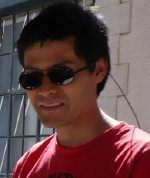 |
Unwarry Instruments (via Skype)
As Researcher I will like to present some of the devices im currently using and hoping to integrate in my sound project for Locus Sonus and E.G.S.
Radiation emissions coming out of the spectrum be them Man-Made, Natural or crossing occurrences defined as “Unnatural” (read also as paranormal and intrapsychic). All to be sensed, traced and as the military will do, mapped. Most often classified as interferences, breakdowns or glitches. A scope that spans from Noise to “"on the clear" comms”. Most likely signals that won'’t produce a Ring!. Few will be routed accordingly by invisible operators, even less will be picked by their intended addressees.
back to programme &mdash back to participants
With a background in video Alejandro Duque is a colombian artist graduated from the school of fine arts of Medellin in Colombia in 1998. He actually pursues a PhD on philosophy of communication at the EGS (European Graduate School http://www.egs.edu/ Switzerland) and his dissertation topic deals with finding ways for smuggling ideas across different networks, "trafficking" concepts crossing marginalized communities and western philosophies. He's member of the Locus Sonus Lab.
Alejandro Duque est un artiste colombien diplômé de l'École d'Art de Medellin en Colombie. Il est actuellement doctorant en thèse de Philosophie de la Communication en Suisse à l'EGS (European Graduate School http://www.egs.edu, Switzerland) et membre du laboratoire Locus Sonus. Sa recherche traite du piratage et de la manière dont les idées sont pillées sur les réseaux (sociaux, internet..) et comment des concepts de communautés marginales sont détournées et confrontées aux philosophies du monde occidental.
|
| |
--> http://co.lab.cohete.net/
|
| |
|
Scott Fitzgerald
 |
Protocol(via Skype)
back to programme &mdash back to participants
Scott Fitzgerald is an artist, educator and technologist, currently member of the Locus Sonus Lab. He builds tools for himself and others to express themselves in unique and idiosyncratic fashions. He holds a Masters degree from New York University's Interactive Telecommunications Program (NYU ITP), and has a variety of previous experiences as a social worker, documentary filmmaker, and radio DJ.
At NYU, Scott has taught Physical Computing, Video for New Media, and Expanding Interactive Video for the last several years, working with students to expand their interactions with machines, and explore the boundaries of video installation and performance.
Scott Fitzgerald est artiste, enseignant et chercheur américain, actuellement membre du laboratoire Locus Sonus.
Il invente et fabrique des outils technologiques, des programmes, des logiciels et des circuits électroniques dédiés et sur mesure pour ses propres projets et pour ceux qu'il développe avec d'autres artistes et collaborateurs. Il est diplômé du Département ITP, (InteractiveTelecommunications Program) de l'Université de New York NYU, il a aussi une expérience de travailleur social, de réalisateur de documentaires et de DJ pour la radio. Il a dispensé des cours de robotique et de programmation dans des Écoles Supérieures et il enseigne depuis plusieurs années les sciences physiques, la vidéo et les nouveaux média à la NYU .
|
| |
--> http://ennuigo.com/
|
| |
|
Florian Grond
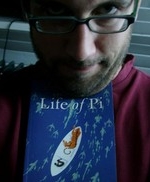 |
Historic music/technological perspective of sonification
Sonification is an interdisciplinary practice ranging from scientific to artistic applications. In practical terms it is often understood as representing data with non-speech sound. This characterization however does not represent the whole challenge and potential of sonification today. From a musical perspective, sonification of data continues where the mimetic capacity of program music and the indexical function of field recording ends.
Sonification therefore wants to represent something but has no sounding point of reference. This problem is shared by scientific as well as artistic sonification approaches. I identify some aesthetic strategies common to many sonifications which try to make up for the missing reference object. In my contribution I will illustrate these aesthetic strategies by historic and contemporary examples.
back to programme &mdash back to participants
Florian Grond, Graz 1975, studied Chemistry at the Karl Franzens University in Graz, at the De Montfort University in Leicester and at the Eberhard Karls University in Tübingen. Since 2002 he worked at the ZKM (center for art and media) in Karlsruhe Germany and the IDMIL at McGill in Montreal. His main scientific focus is sonification and nonlinear dynamical systems. He currently writes a PhD about sonification under the supervision of Thomas Hermann. Since 2002 scientific publishing, since 2004 participating in media art and art/science exhibitions in Germany, Austria, Switzerland, Denmark, Czech Republic, Italy, Japan, US and Canada.
(English version bio only)
|
| |
--> http://www.grond.at/ |
| |
|
Valentina Vuksic
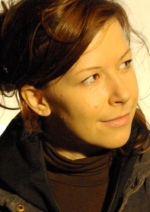 |
Motherboard Pickups
"Tripping Through Runtime" is a long-term study, approaching 'digitality' via microphones for magnetic fields to dive into the invisible relationships of hard and soft computer matters by sensual means. The aim is to detect and provoke specific behaviour of
single computer components in match with software pieces, which are being mediated with the magnetic microphones. These acoustic trips through the magnetic spheres of laptop motherboards move at the borderline between sonification and mystification, raising questions of their purpose.
back to programme &mdash back to participants
With choreographies for computer software and computer parts, Valentina Vuksic puts them into the limelight, turning them into actors of noise pieces for and in computers.
(English version bio only)
|
| |
--> http://www.vimeo.com/4105144
--> http://sei-personaggi-part2.ch
--> http://harddisko.ch |
| |
|
Angus Carlyle
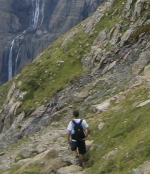
 |
Moderator Roundtable 4 : Transforming Geography
back to programme &mdash back to participants
Interventions précédentes et récentes / Previous and recent lectures
 écoute/listen mp3 Déjà Entendu: Some Thoughts on Sound and its Representation (symposium 4 Extranautes, 2007) écoute/listen mp3 Déjà Entendu: Some Thoughts on Sound and its Representation (symposium 4 Extranautes, 2007)
Angus Carlyle works at the University of the Arts, London where, with Dr. Cathy Lane, he is a Director of CRiSAP.
He has been an intermittent writer for a couple of decades, tackling subjects as diverse as the suicide of Guy Debord and long-distance truck drivers. He has devoted a lot of words to contemporary photography, a process that began when he was the editor of themepark - a magazine that was active across the turn of the millennium – and then continued with texts for gallery catalogues and articles for Hotshoe, Photoworks, Black Dog Press and Eyemazing. He edited Autumn Leaves: Sound and Environment in Artistic Practice for Double Entendre and will soon publish Katch 23, a book about the art-pop band, The KLF.
In recent years, he has been exploring sound in artistic contexts, exhibiting at the DCA Gallery in Tucson, the Zeppelin Festival in Barcelona, in the High Desert Test Sites in Joshua Tree Valley, at London’s E:vent Gallery, on Resonance FM and on the M25 Motorway. He has performed as part of improvising groups in the UK’s oldest cinema, at the Placard Festival and at the Sonic Arts’ Network’s Expo 2008. A CD of his Kami-Katsura recordings will be released by Gruenrekorder in the Spring of 2009. He is a researcher on the multi-disciplinary Positive Soundscape Project.
(English version bio only)
|
| |
--> http://www.crisap.org/
--> http://www.positivesoundscapes.org/
--> http://www.finetuned.org/
--> http://www.vibrofiles.com/essays_autumn_leaves.php
|
| |
|
Jens Brand
 |
G-Turns
back to programme &mdash back to participants
1968
Born in Dortmund, Germany
Lives and works in Cologne, Germany
1987–1994
Studies of fine arts at the Art Academy Muenster, Germany
1992
Founding of the artist initiative „mex e.V.“ www.mexappeal.de in Dortmund, Germany
Artistic director 1992–2006
Jens Brand studied visual arts in Münster, Germany. He lives and works as a composer, musician, visual & audio-visual artist and organiser in Dortmund, Germany. His pieces can appear as concerts, performances or installations. Recent works have ended up being mixtures of these genres, developed as logical and absurd games between the audience and the artist. His experiments with everything that can be considered to be art are not supposed to establish a belief or truth, but try to offer a fruitful soil for research, communication and progressive failure. Pieces used in the collaboration with Sam Ashley, such as Motors and Styrofoam, Mini Fan Music, PIANO or RATCHETS appear as short duration installations that evoke something Jens considers to be "electronic music without speakers".
(English version bio only)
|
| |
--> http://www.jensbrand.com/
--> http://www.g-turns.com/
-->http://www.mexappeal.de/
-->http://www.brueckenmusik.de/ |
| |
|
John Eacott
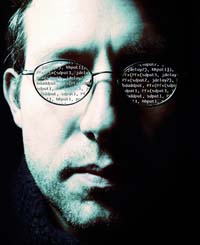 |
Flood Tide and Hour Angle : environmental sonifications
back to programme &mdash back to participants
John Eacott is a trumpeter and composer whose career started in the 1980s with anarchic jazzers Loose Tubes and post-industrial metal bashers Test Dept. In the 1990s he focused on composing many works for Theatre including the worldwide touring production of Gormenghast and arrangements for the 2002 RSC production of Timon of Athens. Film scores include the Miramax feature Three Steps to Heaven (1995), Escape to Life with Vanessa Redgrave (2000) and jazz arrangements for Alfie starring Jude Law (2003). His orchestral compositions have been performed and recorded by the Scottish Chamber Orchestra and Docklands Sinfonietta. Previous algorithmic / generative works include The Street, an interactive sound environment (2000), Morpheus, a CD Rom of generative electronica (2001), and Intelligent Street, a sound space in which users alter their sound environment by sending text messages (2003). Since completing his PhD in 2007, John composed Flood Tide, featured in the 2009 Thames Festival and Hour Angle, which are accessible live performances using algorithmic composition. He is Principal Lecturer in Music at the University of Westminster.
(English version bio only)
|
| |
--> http://www.informal.org/ |
| |
|
Scot Gresham-Lancaster
 |
Remapping : Interest and Abstraction in converting "hard" data for artistic sonic uses
The early works in the sonification of terrain used more and more complex juxtaposition of musical structures that used the raw elevation and position information as a direct determinate in the temporal, timbre and pitch choices. This decision matrix was mutable and very much informed of the types of processes used by Cage, Tudor, Oliveros and others. The performance was procedural but fluid and choices of juxtaposition were based on heuristics with trial and error driving the refinements. Ultimately the textures were made of a multi layered sound map that was made of multiple processes each directly interacting with the digital elevation model in different ways. This high level of parallelism created a context for the elements to bind and react in unexpected ways.
back to programme &mdash back to participants
Scot Gresham-Lancaster is a composer, performer, instrument designer, sound installation builder and educator with over three decades of professional experience. He is dedicated to research and performance using the expanding capabilities of computer networks to create new environments for musical and cross discipline expression. As a member of the HUB, he is one of the early pioneers of "computer network" music which uses the behavior of interconnected music machines to create innovative ways for performers and computers to interact. He has helped develop a new media form called the "cellphone opera" that leverages modern cellphone networks to create sound installations that change with every new participant phone call. For over two decades, he has worked with multimedia prototyping and user interface theory and its relationship to new markets.
A chronological listing of installations and performances at: http://scot.greshamlancaster.com/Chronology.html
Mp3 files:
Rich_Gold_Terrain_Reader_1979.mp3
An excerpt from a live performance that included “the routine nominally called “The Terrain Reader” was part of a broad piece entitled “Fictional Travels in a Mythical Land” by Rich Gold with the League of Automatic Music Composers at the Finnish Hall in SF in 1979. ( ref: Music for an Interactive Network of Microcomputers John Bischoff, Rich Gold and Jim Horton Computer Music Journal , Vol. 2, No. 3 (Dec., 1978), pp. 24-29 Published by: The MIT Press )
McCallExcerpt_particles.mp3
And Terrain_KPFA_Oct_1990_excerpt.mp3
An excerpt from a live broadcast on KPFA Berkeley, CA in 1990 of “Terrain Broadcast” “When released above the terrain, the, the particles moved downward until colliding with the surface.” Events reflecting the velocity of the impact and subsequent virtual bounces were output as MIDI notes. ( Experiences in Digital Terrain: Using Digital Elevation Models for Music and Interactive Multimedia Bill Thibault and Scot Gresham-Lancaster
Leonardo Music Journal , Vol. 7, (1997), pp. 11-15 Published by: The MIT Press )
Toyoji's_Song.mp3
Music generated from the sensor data of Camilie Vineyard in memory of Toyoji Tomita (2009).
(English version bio only)
|
| |
--> http://scot.greshamlancaster.com/
--> http://timespacenote.com/ |
| |
|
Marty Quinn
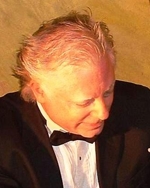 |
MoveMusic : The Perception of Art, Dance, and Science Through Image and Movement Sonification.
MoveMusic Technology makes significant progress toward enabling the perception of dance, art, and any image as music. MoveMusic evolved out of the NASA grant funded museum exhibit “Walk on the Sun”. In the exhibit, visitors could explore over two million images of the changing Sun from the Solar TErrestrial RElations Observatory (STEREO) space mission by literally walking over them and hearing where they walked or moved as music. Explorers could also perceive rapid sequences of images (in essence like movies) as dense chords of music generated from each image in the sequence. With MoveMusic, the sonification is expanded to include movement itself, captured by visual surveillance tracking software. Adding movement sonification to image sonification (i.e., the image that one moves over) creates a rich, multidimensional musical experience giving clues as to what, where, when, and how something is moving. Future work will integrate the sonification design with the conceptual framework for description of movement pioneered by the Laban/Bartenieff Institute of Movement Studies. Long range goals include inclusion of MoveMusic in the 2016 Olympics so those who are blind can better perceive the performance of the athletes.
back to programme &mdash back to participants
Marty Quinn, musician, computer scientist, artist, actor, and founder of Design Rhythmics Sonification Research Lab, collaborates with scientists the world over to turn their data into music to make it accessible through the audio and musical channel. He is working closely with the National Federation of the Blind to bring greater access to imagery and other data through music. He studied acting at the Cleveland Playhouse and is a composer and master drummer who plays drums, tablas, and percussion. As a sonification researcher and computer scientist, His work “The Climate Symphony” which represented 110,000 years of ice core history from the Greenland Ice Sheet Project II was praised by the National Science Foundation for being an innovative merging of art and science. Quinn’s sonifications have been heard on National Public Radio in the US and featured in the New Scientist magazine. He has toured extensively with Broadway shows, Doah World Music Ensemble and with his wife, Wendy, and daughter Caity, in original productions. He trained in computer science and scientific visualization at the Granite State College and the University of New Hampshire. His new “PolyVisual” movies premiered at the Selby Gallery in Sarasota, Florida as part of their “Digital Is” show in 2008.
Wendy Quinn, a native of Montreal, is a choreographer, dancer, artist and visual designer, and was formerly an active member of the avant-garde performing arts community in New York. Wendy has trained in ballet, Tai Chi, and modern dance, and has developed a unique blend of east and west, combined with a deep understanding of the human condition, holding a PsyD degree in Psychology from Antioch New England and a masters in Dance Therapy from Hunter College. She designed the sets for The Seven Valleys and Three Step.
(English version bio only)
|
| |
--> http://www.drsrl.com/ |
| |
|
Cathy Lane
 |
Observer
back to programme &mdash back to participants
CRiSAP (Creative Research into Sound Arts Practice, LCC, Univ. of the Arts London)
Cathy Lane is a co-director of CRiSAP. Previously she established the department of Sound Art and Design at the University of the Arts, London and still teaches undergraduates and supervises research students. She is leading the development of an MA in Sonic Arts to start in January 2008. Cathy Lane has a PhD in electroacoustic music composition from City University.
Dr Cathy Lane is interested in sound and how it relates to the past, our histories, our environment and our collective and individual memories. This informs her current work as a composer, sound artist, lecturer and researcher. Aspects of her creative practice has developed out of these interests and concern composition with spoken word, field recordings and archive material and writing and lectures on these and related subjects.
Cathy Lane is a co-director of CRiSAP. Previously she established the department of Sound Art and Design at the University of the Arts, London and still teaches undergraduates and supervises research students. She is leading the development of an MA in Sonic Arts to start in January 2008.
Cathy Lane has a PhD in electroacoustic music composition from City University.
(English version bio only)
|
| |
--> http://www.crisap.org/
--> http://www.crisap.org/index.php?id=4,58,0,0,1,0
|
| |
|
Jean-Paul Ponthot
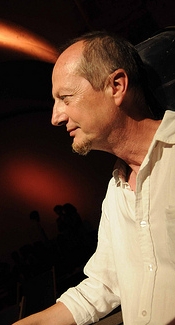 |
Observer
back to programme &mdash back to participants
(French version bio only)
Jean-Paul Ponthot est directeur de l’École d’Art d’Aix-en-Provence depuis 1998. Dès 1986, il entame une réflexion sur les musiques de traverses et sur la manière dont le son crée des rencontres éclectiques avec d'autres formes. Depuis 2000, afin de répondre à la demande des artistes, collectifs et étudiants-artistes de plus en plus ouverts sur les pratiques sonores innovantes, aux confluents de la création en réseau, les installations, les dispositifs multimédia et les arts visuels, il lance via l'École d'Art d'Aix en Provence une réflexion sur un post-diplôme dédié à l'art audio, Locus Sonus.
|
| |
--> http://www.ecole-art-aix.fr/ |
|
